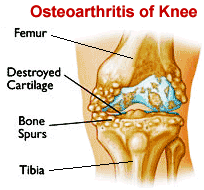Spursing it Up.com

Osteoarthritis of the knee is caused by the loss of the cartilage in your knee joint. When most of the cartilage wears away, the bone will run against each other which will cause pain, swelling, loss of motion, and joint changes. When cartilage is lost, the body responds by making more fluid in the lining of the joints so it can cushion it. This could however, cause more problems to the knee because the additional fluid can cause the joint to swell up; this can limit motion and cause pain, this is called fluid to the knee.
Bone spurs can to be formed on the edges of the joint because of the friction between the bones. Also cartilage can break off and move around inside the knee joint which can cause even more pain and damage.
Symptoms
The main symptom is pain in the knee joints which gets worse when you are active but gets better when you rest. If you have major osteoarthritis, you can have pain even when you’re resting.
It is common to feel stiffness in the morning, which usually last for 30 minutes after you get up and can occur again if you are inactive through the day. Stiffness can make is difficult to do certain activities throughout the day. These activities can include but not limited to:
-
walking
-
climbing stairs
-
squatting or kneeling
-
standing up after sitting
-
getting out of the bathtub
Your knee can also be tender even if there’s no visible evidence of inflammation, so touching the knee can be painful. As said earlier, your knee can swell with fluid as your body tries to heal the area. Sometimes you can feel a crackling or grating feeling when you move the joint.
Causes and Risk Factors
There are many factors that can increase the risk of you getting osteoarthritis in any joint but some risk factors of osteoarthritis in the knee are:
Kneeling and squatting- doing any kind of work that requires frequent kneeling and squatting can lead to a person having osteoarthritis.
Stress in the knee- Carrying heavy items puts extra stress in the knee which puts more wear and tear on the joints. Being overweight can also put extra stress in the knee.
Diagnosis
Medical History
When you go to your doctor appointment, they will ask you some questions about your health. Some of the questions they will ask you are:
-
What kind of work do you do? What kind of work have you done in the past? What sports and other hobbies do you participate in?
-
Have you ever injured your knee?
-
When and how did your symptoms start, and how have they changed over time?
-
How much pain are you having, and does it come and go, or is it constant?
-
When do you feel pain or stiffness, and how long does it last?
-
Do you feel a grinding or grating sensation when you bend or straighten your knee?
-
Do you have family members who have experienced joint problems?
-
What medications are you taking now? What medications have you taken in the past?
Physical Examination
During your examination, the doctors will examine your knee and look for things like:
-
Swelling or fluid around, or behind, the knee joint
-
Tenderness over your knee
-
Bony enlargement of the knee joint
-
Any redness or warmth over the knee, which may indicate infection
-
Loss of ability to fully bend or straighten your knee
Treatment
Doctors goals for treatment are:
-
to decrease pain and minimize swelling
-
to improve knee function
-
to help maintain a healthy body weight
-
to improve quality of life and help achieve a healthy lifestyle
There are several forms of treatment when it comes to knee osteoarthritis which includes, physical therapy, exercise, weight management. medications, joint injections, and if it’s serious surgery. You can talk to your physician to see which treatment works best for you.


Below is an animation of knee osteoarthritis some information that is explained more at the bottom.